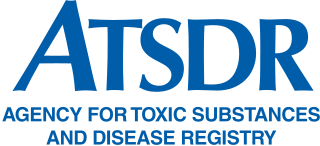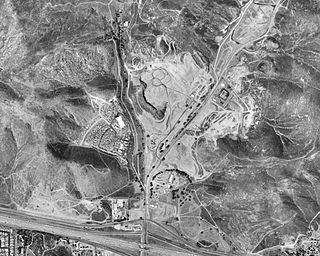Related Research Articles

Hazardous waste is waste that has substantial or potential threats to public health or the environment.

The Environmental Protection Agency (EPA) is an independent executive agency of the United States federal government tasked with environmental protection matters. President Richard Nixon proposed the establishment of EPA on July 9, 1970; it began operation on December 2, 1970, after Nixon signed an executive order. The order establishing the EPA was ratified by committee hearings in the House and Senate. The agency is led by its administrator, who is appointed by the president and approved by the Senate. The current administrator is Michael S. Regan. The EPA is not a Cabinet department, but the administrator is normally given cabinet rank.

Toxic waste is any unwanted material in all forms that can cause harm. Many of today's household products such as televisions, computers and phones contain toxic chemicals that can pollute the air and contaminate soil and water. Disposing of such waste is a major public health issue.

The Agency for Toxic Substances and Disease Registry (ATSDR) is a federal public health agency within the United States Department of Health and Human Services. The agency focuses on minimizing human health risks associated with exposure to hazardous substances. It works closely with other federal, state, and local agencies; tribal governments; local communities; and healthcare providers. Its mission is to "Serve the public through responsive public health actions to promote healthy and safe environments and prevent harmful exposures." ATSDR was created as an advisory, nonregulatory agency by the Superfund legislation and was formally organized in 1985.

The United States federal Superfund law, officially the Comprehensive Environmental Response, Compensation, and Liability Act of 1980 (CERCLA), established the federal Superfund program, administered by the U.S. Environmental Protection Agency (EPA). The program is designed to investigate and clean up sites contaminated with hazardous substances. Sites managed under this program are referred to as "Superfund" sites. There are 40,000 federal Superfund sites across the country, and approximately 1,600 of those sites have been listed on the National Priorities List (NPL). Sites on the NPL are considered the most highly contaminated and undergo longer-term remedial investigation and remedial action (cleanups).

The National Priorities List (NPL) is the priority list of hazardous waste sites in the United States eligible for long-term remedial investigation and remedial action (cleanup) financed under the federal Superfund program. Environmental Protection Agency (EPA) regulations outline a formal process for assessing hazardous waste sites and placing them on the NPL. The NPL is intended primarily to guide EPA in determining which sites are so contaminated as to warrant further investigation and significant cleanup.

The Mel Bernie Company, trading as 1928 Jewelry Company is a manufacturer and wholesaler of costume jewelry and novelties. They also distribute their products directly to consumers through their website.

The California Department of Toxic Substances Control is an agency of the government of the state of California. The mission of the DTSC is to protect public health and the environment from toxic harm. DTSC is part of the California Environmental Protection Agency (Cal/EPA), has more than one thousand employees, and is headquartered in Sacramento. DTSC also has a number of regional offices across the state including two environmental chemistry laboratories, and field offices in Sacramento, Berkeley, Los Angeles, Chatsworth, Commerce, Cypress, Clovis (Fresno), San Diego and Calexico.
"Right to know" empowers "people by allowing them to participate in an informed way in decisions that affect them, while also holding governments and others accountable". It pursues universal access to information as essential foundations of inclusive knowledge societies.

The California Environmental Protection Agency, or CalEPA, is a state cabinet-level agency within the government of California. The mission of CalEPA is to restore, protect and enhance the environment, to ensure public health, environmental quality and economic vitality.

Household hazardous waste (HHW) was a term coined by Dave Galvin from Seattle, Washington in 1982 as part of the fulfillment of a US EPA grant. This new term was reflective of the recent passage of the Resource Conservation and Recovery Act of 1976 in the US. This act and subsequent regulations strengthened the environmental protection requirements for landfills, in Subpart D, and created a "cradle to grave" management system for hazardous wastes, in Subpart C. From RCRA 1976 the US EPA promulgated rules in 1980 which explicitly excluded any wastes from household origins from regulation as a hazardous waste at the federal level. Most US states adopted parallel regulations to RCRA 1976 but were allowed to be more stringent. California took advantage of this allowance and chose to not exempt household origin wastes from their state hazardous waste laws. HHW products exhibit many of the same dangerous characteristics as fully regulated hazardous waste which are their potential for reactivity, ignitability, corrosivity, toxicity, or persistence. Examples include drain cleaners, oil paint, motor oil, antifreeze, fuel, poisons, pesticides, herbicides and rodenticides, fluorescent lamps, lamp ballasts containing PCBs, some smoke detectors, and in some states, consumer electronics. Except for California, most states exclude HHW from their hazardous waste regulations and regulate the management of HHW largely under their solid waste regulatory schemes.

The Environmental Protection Administration, Executive Yuan is a cabinet-level executive agency responsible for protecting and conserving the environment in the Republic of China (Taiwan). This also includes, air quality, noise control, monitoring and inspection of environment, solid waste, recycling, sustainable development and international cooperation.

The Office of Environmental Health Hazard Assessment, commonly referred to as OEHHA, is a specialized department within the cabinet-level California Environmental Protection Agency (CalEPA) with responsibility for evaluating health risks from environmental chemical contaminants.

Waste management laws govern the transport, treatment, storage, and disposal of all manner of waste, including municipal solid waste, hazardous waste, and nuclear waste, among many other types. Waste laws are generally designed to minimize or eliminate the uncontrolled dispersal of waste materials into the environment in a manner that may cause ecological or biological harm, and include laws designed to reduce the generation of waste and promote or mandate waste recycling. Regulatory efforts include identifying and categorizing waste types and mandating transport, treatment, storage, and disposal practices.

The Kettleman Hills Hazardous Waste Facility is a large hazardous waste and municipal solid waste disposal facility, operated by Waste Management, Inc. The landfill is located at 35.9624°N 120.0102°W, 3.5 mi (5.6 km) southwest of Kettleman City on State Route 41 in the western San Joaquin Valley, Kings County, California.

The Stringfellow Acid Pits are a toxic waste dump, and a Superfund site, located in Jurupa Valley, California, United States, just north of the neighborhood of Glen Avon. The site became the center of national news coverage in the early 1980s, in part because it was considered one of the most polluted sites in California, and because it became linked with mismanagement and scandal in the U.S. Environmental Protection Agency.
The California Green Chemistry Initiative (CGCI) is a six-part initiative to reduce public and environmental exposure to toxins through improved knowledge and regulation of chemicals; two parts became statute in 2008. The other four parts were not passed, but are still on the agenda of the California Department of Toxic Substances Control green ribbon science panel discussions. The two parts of the California Green Chemistry Initiative that were passed are known as AB 1879 : Hazardous Materials and Toxic Substances Evaluation and Regulation and SB 509 : Toxic Information Clearinghouse. Implementation of CGCI has been delayed indefinitely beyond the January 1, 2011.

Pesticide regulation in the United States is primarily a responsibility of the Environmental Protection Agency. In America, it was not till the 1950s that pesticides were regulated in terms of their safety. The Pesticides Control Amendment (PCA) of 1954 was the first time Congress passed guidance regarding the establishment of safe limits for pesticide residues on food. It authorized the FDA to ban pesticides they determined to be unsafe if they were sprayed directly on food. The Food Additives Amendment, which included the Delaney Clause, prohibited the pesticide residues from any carcinogenic pesticides in processed food. In 1959, pesticides were required to be registered.
The Hazardous Waste and Substances Sites List, also known as the Cortese List—named for Dominic Cortese—or California Superfund, is a planning document used by the State of California and its various local agencies and developers to comply with the California Environmental Quality Act requirements in providing information about the location of hazardous materials release sites. California Government Code section 65962.5 requires the California Environmental Protection Agency to develop at least an annually updated Cortese List.
References
- ↑ "CalEPA Unified Program". California Environmental Protection Agency. Retrieved 2014-09-03.
- ↑ "CalEPA Unified Program Fact Sheet (March 2012)" (PDF). California Environmental Protection Agency. Archived from the original (PDF) on 2015-09-23. Retrieved 2014-09-03.
- ↑ "More about CalEPA Unified Program". California Environmental Protection Agency. Archived from the original on 2014-08-07. Retrieved 2014-09-03.
- ↑ "DTSC CUPA Home Page". Department of Toxic Substances Control. Archived from the original on 2014-09-07. Retrieved 2014-09-03.
- ↑ "Executive Management Short Biography – (CalEPA) | CalEPA".